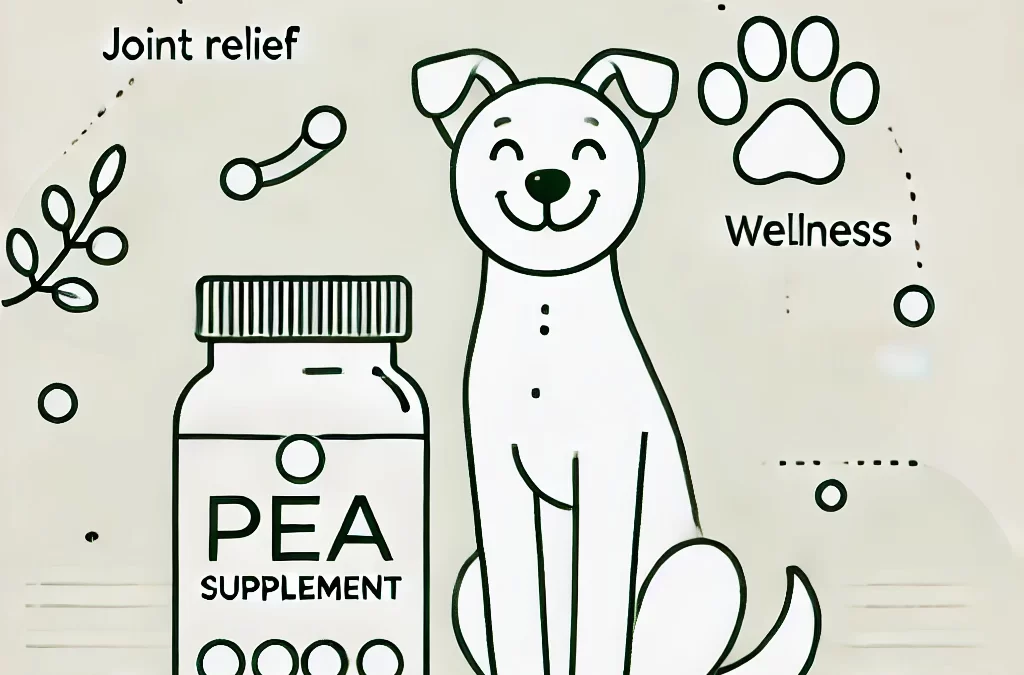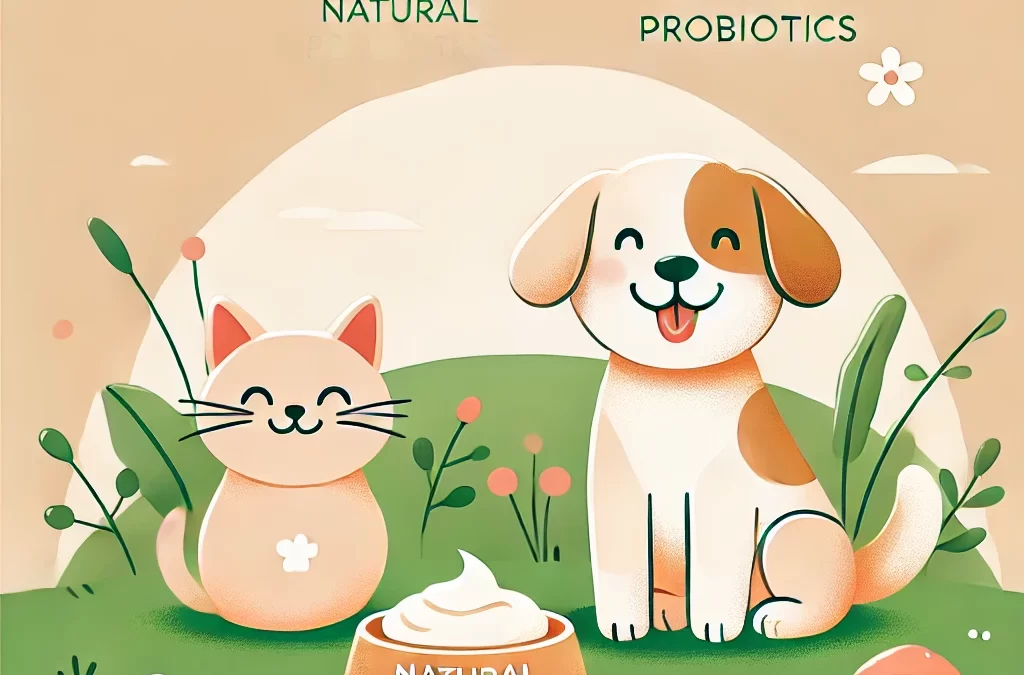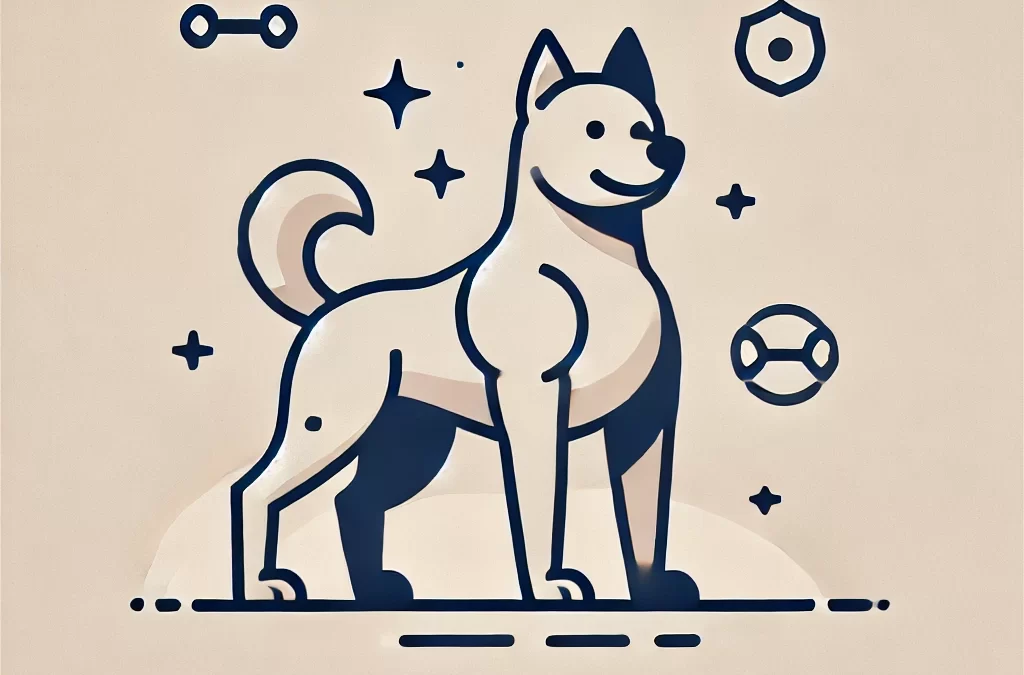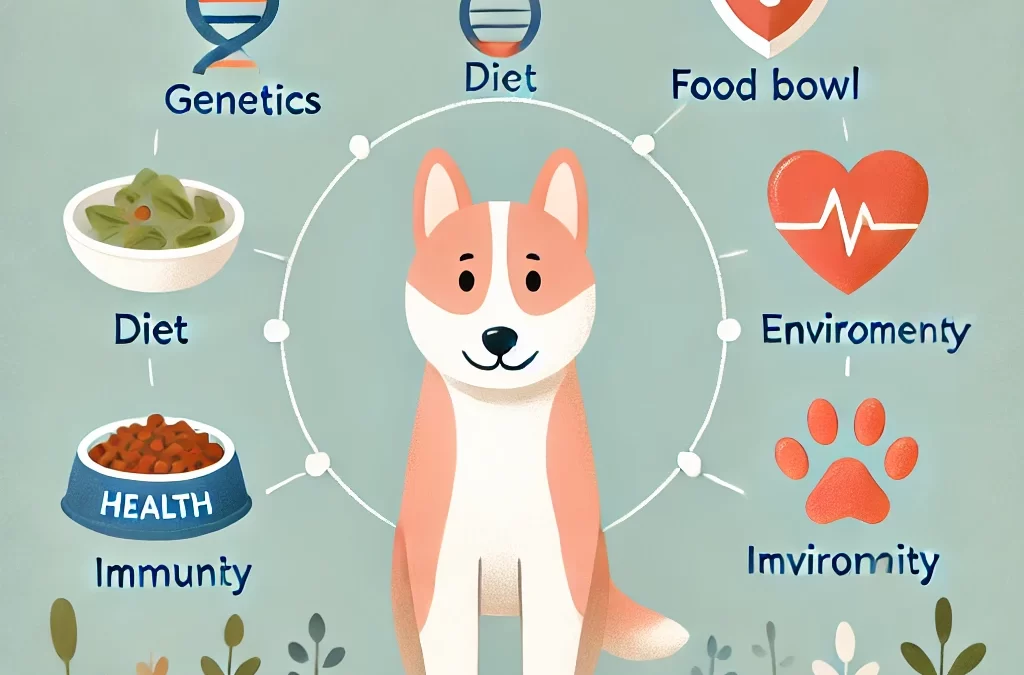
door TCMVET | 13 november 2024 | Voedsel & Gezondheid
Palmitoylethanolamide, of PEA, wint aan populariteit in de wereld van hondenverzorging vanwege de natuurlijke pijnstillende en ontstekingsremmende eigenschappen. Oorspronkelijk ontdekt als een door het lichaam geproduceerd vetzuuramide, is PEA een endocannabinoïde-achtige verbinding die in verschillende weefsels voorkomt, waaronder de hersenen en het immuunsysteem. Deze unieke verbinding, aanwezig in voedingsmiddelen zoals eieren en soja, heeft potentiële voordelen getoond bij het ondersteunen van pijnbestrijding en het verminderen van ontstekingen bij zowel mensen als dieren. Maar wat betekent het voor onze hondenvrienden?
Wat is PEA en waarom is het nuttig voor honden?
PEA wordt van nature geproduceerd in het lichaam van zowel mensen als honden als reactie op ontstekingen en pijn. Als endogene verbinding werkt PEA samen met het endocannabinoïdesysteem om ontstekingen en pijnperceptie te moduleren zonder psychoactieve effecten. Dit maakt het een veiliger alternatief voor huisdieren vergeleken met traditionele farmaceutische middelen, vooral voor langdurig gebruik.
Belangrijkste voordelen van PEA voor honden:
- Pijnstilling: PEA werkt in op receptoren in het zenuwstelsel en zorgt op een natuurlijke manier voor vermindering van ongemak.
- Ontstekingsremmende eigenschappen: Het beïnvloedt de immuunreactie van het lichaam om ontstekingen te verminderen, wat gunstig kan zijn voor honden die lijden aan artritis, dermatitis en andere ontstekingsaandoeningen.
- Improved Quality of Life: Door pijn en ontstekingen te verlichten, kan PEA de mobiliteit, het energieniveau en het algemene welzijn verbeteren.
Hoe werkt PEA?
In tegenstelling tot andere pijnstillers blokkeert PEA de pijnsignalen niet rechtstreeks. In plaats daarvan werkt het op wat bekend staat als het "entourage-effect", waarbij de natuurlijke processen die pijn en ontsteking reguleren worden versterkt. Hier is een vereenvoudigde blik op hoe het werkt:
- Interactie met cannabinoïde receptoren: PEA werkt indirect samen met cannabinoïde receptoren (CB2 receptoren) in het immuunsysteem en bevordert zo een evenwichtige immuunrespons.
- Remming van ontstekingsenzymen:Het remt enzymen die ontstekingen aanwakkeren, waardoor de natuurlijke genezingsprocessen van het lichaam effectiever kunnen werken.
- Stabilisatie van mestcellen: PEA stabiliseert mestcellen, immuuncellen die histamine vrijgeven als reactie op verwondingen of ontstekingen, waardoor ontstekingsgerelateerd ongemak wordt verminderd.
Bij welke aandoeningen kan PEA helpen bij honden?
PEA kan gunstig zijn voor honden met verschillende chronische aandoeningen:
- Artritis:De ontstekingsremmende werking kan helpen bij honden met gewrichtsontstekingen en stijfheid.
- Skin Conditions: Honden met chronische dermatitis kunnen verlichting ervaren van jeuk en irritatie.
- Neurologische aandoeningen:Sommige onderzoeken suggereren dat PEA honden met zenuwgerelateerde pijn kan helpen door overactieve zenuwcellen te kalmeren.
- Herstel na de operatie:De pijnstillende eigenschappen van PEA kunnen een sneller herstel en pijnbestrijding na een operatie ondersteunen.
Veilig gebruik van PEA: dosering en voorzorgsmaatregelen
PEA wordt over het algemeen goed verdragen, maar het is belangrijk om een veilige aanpak te volgen:
- Raadpleeg een dierenarts: Overleg altijd met een dierenarts voordat u PEA aan de routine van uw hond toevoegt, vooral als hij/zij ook andere medicijnen gebruikt.
- Begin langzaam: Introduceer PEA in kleinere doses en let op eventuele reacties. PEA is doorgaans verkrijgbaar in tablet-, poeder- of kauwvorm, met doseringsaanbevelingen op basis van lichaamsgewicht.
- Observeren en aanpassen: Houd de reactie van uw hond in de gaten en pas indien nodig de dosering aan onder toezicht van een dierenarts.
Het kiezen van het juiste PEA-supplement voor uw hond
Niet alle PEA-supplementen zijn hetzelfde. Let bij het selecteren van een PEA-product op:
- Zuiverheid en kwaliteit: Kies supplementen die getest zijn op zuiverheid en vrij zijn van verontreinigingen.
- Gemicroniseerde vorm:Deze vorm van PEA is beter biologisch beschikbaar, wat betekent dat het effectiever wordt opgenomen in het lichaam van uw hond.
- Producten speciaal voor honden:Sommige merken ontwikkelen PEA speciaal voor huisdieren, zodat de juiste dosering en samenstelling gegarandeerd is.
Laatste gedachten: De toekomst van PEA in de verzorging van huisdieren
Omdat steeds meer huisdiereigenaren op zoek zijn naar natuurlijke opties om het leven van hun hond te verbeteren, springt PEA eruit als een veelbelovende aanvulling. De veelzijdige aanpak van pijnbestrijding en ontstekingsmanagement kan ouder wordende huisdieren, huisdieren met chronische aandoeningen en elke hond die behoefte heeft aan veilige, zachte ondersteuning voor welzijn ten goede komen.
Met groeiend onderzoek en meer huisdierspecifieke formuleringen kan PEA binnenkort een hoofdbestanddeel worden in holistische huisdierverzorging. De unieke mechanismen en bewezen veiligheid maken het een levensvatbare, innovatieve optie voor het ondersteunen van het comfort en de vitaliteit van honden zonder de bijwerkingen van conventionele medicijnen.

door TCMVET | 13 november 2024 | Voedsel & Gezondheid
Net als mensen kunnen huisdieren veel baat hebben bij probiotica, de "goede bacteriën" die de gezondheid van de darmen, immuniteit en algehele gezondheid ondersteunen. Hoewel commerciële probiotica populair zijn, komen natuurlijke bronnen van probiotica naar voren als een effectieve en holistische benadering. Dit artikel duikt in wat natuurlijke probiotica zijn, waar ze te vinden zijn en hoe ze de gezondheid van uw huisdier op natuurlijke wijze kunnen verbeteren.
1. Wat zijn natuurlijke probiotica voor huisdieren?
- DefinitieNatuurlijke probiotica zijn levende, nuttige bacteriën die voorkomen in natuurlijk gefermenteerde voedingsmiddelen, kruiden en planten.
- Hoe ze werken:Deze micro-organismen helpen het darmmicrobioom in evenwicht te brengen, verbeteren de spijsvertering, versterken de immuunreactie en kunnen zelfs een positieve invloed hebben op de stemming.
- Verschil met commerciële probiotica: Natuurlijke probiotica zijn afkomstig van onbewerkte voeding en zijn minder bewerkt. Ze bieden dus een oplossing die dichter bij de natuur staat.
2. Voordelen van natuurlijke probiotica voor huisdieren:
- Betere spijsverteringProbiotica kunnen helpen bij het afbreken van voedsel, het absorberen van voedingsstoffen en het verminderen van spijsverteringsproblemen zoals gasvorming of diarree.
- Sterkere immuniteit:Een evenwichtige darmflora versterkt het immuunsysteem, waardoor huisdieren infecties effectiever kunnen bestrijden.
- Allergie verlichtingRegelmatige inname van probiotica kan huidallergieën verlichten door de ontsteking in de darmen te verminderen, waar veel immuunreacties ontstaan.
- Stemming en gedragUit onderzoek blijkt dat er een verband bestaat tussen de gezondheid van de darmen en stemming. Dit suggereert dat probiotica een kalmerend effect kunnen hebben op huisdieren.
3. Bronnen van natuurlijke probiotica voor huisdieren:
- Yoghurt en Kefir: Gewone, ongezoete yoghurt en kefir zijn rijk aan probiotica zoals Lactobacillus acidophilus En BifidobacteriënDeze kunnen de spijsvertering ondersteunen als ze in kleine, veilige hoeveelheden worden gegeven.
- Gefermenteerde groenten:Kleine hoeveelheden gefermenteerde groenten zoals zuurkool (ongezouten) kunnen probiotica bieden, maar hiermee moet voorzichtig worden omgegaan.
- Appelazijn: Rauwe appelazijn bevat enzymen en nuttige bacteriën, maar moet voor gebruik verdund worden om spijsverteringsproblemen te voorkomen.
- Kruiden en op de bodem levende organismen: Bepaalde kruiden zoals paardenbloemwortel en cichoreiwortel bevatten prebiotica, die nuttige bacteriën voeden. Daarnaast kunnen op aarde gebaseerde probiotica die in diervriendelijke biologische grond worden aangetroffen, de gezondheid van de darmen op natuurlijke wijze ondersteunen.
4. Hoe u natuurlijke probiotica aan het dieet van uw huisdier kunt toevoegen
- Begin klein: Geef het in kleine hoeveelheden en let op eventuele spijsverteringsstoornissen of -reacties.
- Observeren en aanpassen: Als uw huisdier er baat bij lijkt te hebben, verhoog dan geleidelijk de frequentie of hoeveelheid zoals geadviseerd door uw dierenarts.
- Consistentie is de sleutelRegelmatige, consistente doses natuurlijke probiotica leveren doorgaans de beste resultaten op. Zoek daarom een methode die past bij de dagelijkse routine van uw huisdier.
5. Wanneer u natuurlijke probiotica moet overwegen in plaats van supplementen
- Voor gevoelige huisdierenHuisdieren die commerciële probioticasupplementen niet goed verdragen, reageren mogelijk beter op natuurlijke bronnen.
- Post-antibioticabehandeling:Na een antibioticakuur kunnen natuurlijke probiotica helpen het darmmicrobioom te herstellen.
- Dagelijkse gezondheidscontrole:Als u op zoek bent naar een preventieve aanpak, kunnen natuurlijke probiotica een milde, effectieve optie zijn voor uw dagelijkse gezondheid.
6. Veiligheidstips en waar u op moet letten
- Vermijd additieven: Kies voor pure, smaakloze en ongezoete probioticabronnen, want toevoegingen zoals suiker en kunstmatige smaakstoffen kunnen schadelijk zijn voor huisdieren.
- Consult Your Vet: Overleg altijd met uw dierenarts, vooral als uw huisdier onderliggende gezondheidsproblemen of allergieën heeft.
- Controleer op bijwerkingen: In zeldzame gevallen kunnen huisdieren last krijgen van milde diarree of een opgeblazen gevoel, omdat hun lichaam zich moet aanpassen aan de nieuwe probiotica.
Conclusie:
Natuurlijke probiotica bieden een holistische manier om de gezondheid van uw huisdier te verbeteren, door de spijsvertering, immuniteit en zelfs stemming te ondersteunen. Door veilige, natuurlijke bronnen van probiotica te introduceren, biedt u een natuurlijker pad naar welzijn. Met geduld en consistentie kunnen deze natuurlijke helpers een essentieel onderdeel worden van de routine van uw huisdier voor een gelukkiger, gezonder leven.

door TCMVET | 13 november 2024 | Hondenkanker en tumoren
Vetbulten, of lipomen, zijn een van de meest voorkomende niet-kankerachtige gezwellen bij honden, vooral naarmate ze ouder worden. Huisdiereigenaren voelen zich vaak ongerust wanneer ze deze bulten ontdekken, maar de meeste lipomen zijn goedaardig. In dit artikel onderzoeken we hoe deze bulten aanvoelen, hoe u ze kunt onderscheiden van andere gezwellen en geven we tips over wanneer u een dierenarts moet raadplegen.
1. Wat zijn vetknobbels?
- Definitie van lipomenLipomen zijn zachte, vette afzettingen die zich onder de huid vormen, meestal bij oudere of te zware honden.
- Algemene locaties: Meestal te vinden op de romp, oksels en ledematen, maar kan op verschillende plaatsen voorkomen.
- Oorzaak:Hoewel de exacte oorzaken niet volledig bekend zijn, kunnen ze verband houden met leeftijd, ras, genetica en gewicht.
2. Het gevoel van vetknobbels:
- Zacht en beweeglijk: Lipomen zijn over het algemeen zacht en lichtjes squishy, en voelen een beetje als een klomp deeg onder de huid. Ze zijn gemakkelijk te verplaatsen met een zachte duw, wat ze vaak onderscheidt van hardere, minder mobiele gezwellen.
- Niet pijnlijk: In tegenstelling tot cysten of abcessen zijn lipomen niet pijnlijk, tenzij ze op een zenuw of gewricht drukken.
- Consistente textuurLipomen voelen meestal overal hetzelfde aan, met een homogene, deegachtige textuur.
3. Verschillen tussen lipomen en andere soorten knobbels:
- Cysts: Cysten zijn vaak steviger, gevuld met vocht en hebben soms een centraal punt, in tegenstelling tot de uniformiteit van een lipoom.
- Abcessen: Deze zijn meestal pijnlijk en voelen warm aan, vaak gepaard gaand met roodheid.
- Kankerachtige gezwellen: Kwaadaardige knobbels kunnen harder aanvoelen, zitten vaak vast op hun plek en kunnen snel of onregelmatig groeien. Tumoren kunnen onregelmatig van vorm of stevig aanvoelen.
- Fibromen:Deze goedaardige tumoren voelen steviger aan dan lipomen en zijn minder mobiel, maar zijn meestal ongevaarlijk.
4. Wanneer moet u zich zorgen maken?
- Groeipercentage:Als een bult snel groeit, van vorm verandert of pijnlijk wordt, is het het beste om onmiddellijk een dierenarts te raadplegen.
- Locatieproblemen: Bulten in de buurt van gewrichten of op plekken die de mobiliteit beïnvloeden, moeten mogelijk worden verwijderd of gecontroleerd.
- Meerdere klonten: Meerdere lipomen komen vaak voor bij sommige rassen, maar als er snel nieuwe bulten ontstaan, overweeg dan om een dierenarts te raadplegen.
5. Lipomen diagnosticeren:
- Veterinair onderzoek: Een dierenarts kan door palpatie vaststellen of een knobbel een lipoom is.
- Fijne naaldaspiratie (FNA)Voor een definitievere diagnose kan FNA cellen uit de knobbel verzamelen en analyseren. Zo kan duidelijkheid worden verkregen over de vraag of de knobbel goedaardig is of nader onderzoek vereist.
6. Moeten lipomen verwijderd worden?
- Wanneer een operatie nodig isLipomen worden over het algemeen met rust gelaten, tenzij ze ongemak veroorzaken, de beweging beperken of buitensporig groeien.
- Minimaal invasieve opties:Nieuwere methoden, zoals liposuctie of steroïde-injecties, kunnen in sommige gevallen helpen lipomen te verminderen.
7. Preventie- en gezondheidstips voor het verminderen van lipomen:
- Zorg voor een gezond gewicht: Obesitas is een bekende risicofactor voor lipomen.
- Regelmatige controlesRegelmatige bezoeken aan de dierenarts maken het mogelijk om nieuwe gezwellen vroegtijdig te ontdekken en in de gaten te houden.
- Evenwichtige voeding en beweging:Een evenwichtig dieet en regelmatige lichaamsbeweging kunnen obesitas helpen voorkomen, wat de kans op lipomen kan verkleinen.
Conclusie: Hoewel vetbulten bij honden zorgwekkend kunnen zijn, zijn ze vaak ongevaarlijk en gemakkelijk te behandelen. Door het gevoel, de oorzaken en symptomen van lipomen te begrijpen, kunnen hondenbezitters weloverwogen beslissingen nemen over de gezondheid van hun huisdier. Als u niet zeker weet of uw hond een bult heeft, vraag dan altijd professioneel advies voor uw gemoedsrust.

door TCMVET | 12 november 2024 | Hondenkanker en tumoren
Voor huisdiereigenaren die hun hond willen helpen om magere spieren te ontwikkelen, kracht te vergroten of te herstellen van een blessure, kan het idee van spieropbouwsupplementen intrigerend lijken. Hoewel het niet standaard is voor elke hond, kunnen deze supplementen bepaalde rassen, energieke honden, werkhonden en zelfs honden die herstellende zijn, ten goede komen. Hier gaan we dieper in op de voordelen van spieropbouwsupplementen voor honden, de belangrijkste ingrediënten waar u op moet letten en tips voor het kiezen van veilige en effectieve producten.
1. Waarom spieren belangrijk zijn voor honden
Een gezond spierstelsel is van vitaal belang voor elke hond, niet alleen voor de actieve of atletische honden. Spieren helpen gewrichten te ondersteunen, verbeteren het uithoudingsvermogen en behouden de algehele mobiliteit. Voor honden die betrokken zijn bij behendigheid, jagen of andere intensieve activiteiten, kunnen sterke spieren helpen blessures te voorkomen en de prestaties te verbeteren. Daarnaast kunnen oudere honden, honden die herstellen van een operatie en honden met bepaalde aandoeningen zoals artritis profiteren van spierondersteuning om kracht te behouden en ongemak te verminderen.
2. Voor wie zijn spieropbouwsupplementen geschikt?
Spieropbouwsupplementen zijn niet voor alle honden nodig, maar ze kunnen wel nuttig zijn voor:
- Actieve rassen: Rassen zoals bordercollies, Duitse herders en labradors zijn van nature energiek en gedijen goed bij een gestructureerd trainingsschema.
- Werkhonden: Politie-, militaire en hulphonden hebben vaak extra fysieke vaardigheden nodig.
- Seniorenhonden: Oudere honden kunnen na verloop van tijd spiermassa verliezen. Supplementen kunnen helpen de spiertonus te behouden, wat de gezondheid van de gewrichten ondersteunt.
- Honden in herstel: Honden die herstellen van een operatie of blessure hebben mogelijk extra ondersteuning nodig om hun kracht en mobiliteit te herstellen.
3. Belangrijkste ingrediënten om op te letten
Niet alle spieropbouwsupplementen zijn gelijk, dus het begrijpen van de voordelen van ingrediënten kan helpen bij het selecteren van een kwaliteitsproduct. Dit zijn de beste ingrediënten die de spiergezondheid kunnen ondersteunen:
- Aminozuren: Bouwstenen van eiwitten, aminozuren zoals L-carnitine en L-glutamine helpen bij spierontwikkeling en herstel. Deze zijn cruciaal voor honden die magere spieren opbouwen of behouden.
- Creatine: Hoewel creatine vaak wordt geassocieerd met bodybuilding door mensen, is het een natuurlijke verbinding die honden kan helpen hun spierprestaties te verbeteren. Het is vooral gunstig voor korte energie-uitbarstingen, zoals sprinten of behendigheidstraining.
- Omega-3 vetzuren: Deze gezonde vetten staan erom bekend ontstekingen te verminderen, wat kan helpen bij herstel na het sporten. Omega-3's kunnen ook de gezondheid van gewrichten ondersteunen, waardoor ze een goede aanvulling zijn op een spiergericht supplement.
- Eiwitbronnen: Hoogwaardige eiwitbronnen zoals kip, vis of rundvlees leveren essentiële voedingsstoffen voor spiergroei en -herstel. Sommige spieropbouwsupplementen bevatten gedehydrateerd eiwitpoeder.
- Gewrichtsondersteunende middelen: Ingrediënten zoals glucosamine en chondroïtine zijn niet direct gericht op spieropbouw, maar ze ondersteunen wel de gezondheid van de gewrichten. Dit is essentieel voor actieve honden die spieren willen opbouwen en behouden.
4. Het kiezen van het juiste spieropbouwsupplement
Houd bij het kiezen van een voedingssupplement rekening met de volgende tips. Zo weet u zeker dat u uw hond het veiligste en meest effectieve product geeft:
- Kies hondspecifieke producten: Sommige supplementen voor spieropbouw bij mensen kunnen schadelijk zijn voor honden. Zoek naar producten die speciaal zijn samengesteld voor de fysiologie van honden.
- Controleer op ingrediënten van hoge kwaliteit: Hoe minder vulstoffen, kunstmatige smaakstoffen of conserveringsmiddelen, hoe beter. Een goed supplement moet rijk zijn aan hele ingrediënten.
- Praat met uw dierenarts: Raadpleeg uw dierenarts voordat u met een supplement begint, vooral als uw hond al gezondheidsproblemen heeft.
- Begin langzaam: Introduceer elk nieuw supplement geleidelijk en kijk hoe uw hond erop reageert. Vermijd het geven van meer dan de aanbevolen dosis.
5. Supplementen vs. Natuurlijk Dieet
Supplementen kunnen een handige manier zijn om de spiergezondheid van uw hond te verbeteren, maar een uitgebalanceerd dieet is fundamenteel. Diëten met veel eiwitten, waaronder mager vlees, eieren en wat vis, kunnen de spiergezondheid op natuurlijke wijze ondersteunen. Supplementen zijn het meest effectief in combinatie met goede voeding en een goede trainingsroutine.
6. Spieren opbouwen door middel van oefeningen en training
Supplementen alleen kunnen geen spieren opbouwen; een goed gestructureerde trainingsroutine is essentieel. Concentreer u op activiteiten die het hele lichaam betrekken, zoals:
- Verzwaarde wandelingen of hiken: Door een lichte rugzak te bevestigen, kunt u gezonde honden een lichte weerstand bieden.
- Behendigheidstraining: Bevordert de flexibiliteit en bouwt kracht op, terwijl uw hond mentaal gestimuleerd blijft.
- Zwemmen: Zwemmen is een oefening met een lage impact, waardoor het uitstekend is voor de spiergroei en gezonde gewrichten.
Conclusie: een sterkere, gezondere hond opbouwen
Spieropbouwsupplementen kunnen een waardevolle aanvulling zijn voor honden die een krachtboost nodig hebben, maar ze werken het beste in combinatie met uitgebalanceerde voeding en beweging. Door zorgvuldig hoogwaardige supplementen te kiezen en uw dierenarts op de hoogte te houden, kunt u de spiergezondheid van uw hond ondersteunen, zodat hij actief, sterk en klaar blijft voor de avonturen van het leven.

door TCMVET | 12 november 2024 | Hondenkanker en tumoren
Kanker is een van de meest uitdagende ziekten voor zowel mensen als huisdieren, en het is vooral hartverscheurend als het onze geliefde honden treft. Maar begrijpen waarom en hoe kanker zich ontwikkelt bij honden kan licht werpen op preventie en inzicht bieden in vroege detectie. Hoewel er geen zekere manier is om kanker te voorkomen, laten we de belangrijkste bijdragende factoren, opkomend onderzoek en manieren waarop we kunnen helpen risico's te verminderen, onderzoeken.
1. Genetica: de invloed van ras en familiegeschiedenis
Sommige rassen hebben een hogere aanleg voor kanker. Bijvoorbeeld, rassen als Golden Retrievers, Boxers en Rottweilers zijn genetisch geneigd om bepaalde vormen van kanker te ontwikkelen. Onderzoek suggereert dat erfelijke genetische mutaties een belangrijke rol spelen in deze neigingen. Een studie gepubliceerd in Genetica en epidemiologie van honden onthulde dat bepaalde rassen gedeelde genetische eigenschappen hebben die hen vatbaarder maken voor tumoren. Als gevolg hiervan kan de afkomst van een hond het risico verhogen, wat betekent dat huisdiereigenaren van bepaalde rassen extra waakzaam moeten zijn met regelmatige controles bij de dierenarts.
2. Omgevingsfactoren: kankerverwekkende stoffen en dagelijkse gifstoffen
Honden worden net als mensen blootgesteld aan omgevingsgifstoffen. Veelvoorkomende boosdoeners zijn meeroken, bepaalde schoonmaakmiddelen, pesticiden en vervuiling. Honden kunnen, door hun nauwe contact met vloeren en buitenoppervlakken, gemakkelijk schadelijke stoffen inslikken of inademen, waardoor ze onbewust gifstoffen in hun lichaam brengen. Er is ook steeds meer bewijs dat een direct verband aantoont tussen blootstelling aan specifieke carcinogenen en een verhoogd risico op kanker bij honden.
Bruikbare inzichten: Om blootstelling aan pesticiden te minimaliseren, kunt u overwegen om natuurlijke schoonmaakmiddelen te gebruiken, niet te roken in de buurt van huisdieren en ervoor te zorgen dat de speelplekken van uw hond vrij zijn van pesticiden.
3. Dieet: de rol van voeding bij kankerpreventie
Wat een hond eet, kan een diepgaand effect hebben op zijn gezondheid en alles beïnvloeden, van immuunfunctie tot cellulaire gezondheid. Voedsel van slechte kwaliteit, met veel vulstoffen en kunstmatige toevoegingen, kan bijdragen aan cellulaire mutaties en ontstekingen, wat mogelijk kan leiden tot kanker. Aan de andere kant kan een uitgebalanceerd dieet, rijk aan antioxidanten, omega-vetzuren en natuurlijke eiwitten, cellulair herstel en immuunverdediging ondersteunen.
Dieetadvies: Overweeg om over te stappen op hoogwaardige, biologische of zelfs zelfgemaakte maaltijden die zijn afgestemd op de voedingsbehoeften van uw hond. Raadpleeg altijd een dierenarts voor advies over het beste dieet.
4. Hormonale invloeden en reproductieve gezondheid
Hormonen zijn krachtige chemische boodschappers in het lichaam en ze kunnen de groei van tumoren beïnvloeden. Onderzoeken hebben aangetoond dat sterilisatie of castratie op de juiste leeftijd het risico op bepaalde vormen van kanker, zoals borst- of teelbalkanker, kan verminderen. De timing van deze procedures is echter essentieel, aangezien vroege sterilisatie of castratie in verband is gebracht met een verhoogd risico op andere vormen van kanker, zoals osteosarcoom.
Evenwichtige beslissing: Bespreek met uw dierenarts wat het beste moment is om uw hond te laten steriliseren of castreren. De timing kan namelijk verschillen, afhankelijk van het ras en de gezondheid van de hond.
5. Infecties en virussen
Bepaalde infecties en virussen staan erom bekend kankerverwekkend te zijn. Bij honden kunnen virussen zoals het canine papillomavirus wratten veroorzaken die zich in zeldzame gevallen kunnen ontwikkelen tot kwaadaardige tumoren. Bovendien kunnen infecties die chronische ontstekingen veroorzaken, na verloop van tijd leiden tot cellulaire veranderingen en mutaties, wat mogelijk kan leiden tot kanker.
6. Veroudering: de onvermijdelijke factor
Leeftijd is een van de belangrijkste risicofactoren voor kanker bij honden. Met verbeteringen in veterinaire zorg leven honden langer en met de leeftijd neemt de kans op kanker toe. Naarmate de cellen van een hond ouder worden, kunnen de mechanismen voor het herstellen van DNA-schade minder efficiënt worden, waardoor het gemakkelijker wordt voor kankermutaties.
Preventieve maatregelen en veranderingen in levensstijl voor een gezonder leven
Hoewel niet alle gevallen van kanker te voorkomen zijn, kunnen bepaalde aanpassingen in de levensstijl helpen om de risico's te verminderen. Hier zijn enkele preventieve maatregelen die de gezondheid op de lange termijn kunnen bevorderen:
- Routine Veterinary Care: Regelmatige controles helpen om abnormale gezwellen of vroege waarschuwingssignalen op te sporen.
- Gezonde dieetkeuzes: Kies voor voeding die rijk is aan essentiële voedingsstoffen en vrij is van kunstmatige toevoegingen en vulstoffen.
- Zorg voor een schone omgeving: Gebruik niet-giftige producten en voorkom dat uw hond wordt blootgesteld aan schadelijke chemicaliën.
- Regelmatig bewegen: Door uw hond actief te houden, versterkt u zijn immuunsysteem, wat van essentieel belang is bij het bestrijden van ziektes.
Conclusie: Kennis als onze beste verdediging
Inzicht in de factoren die bijdragen aan kanker bij honden kan ons helpen om weloverwogen keuzes te maken en, waar mogelijk, het risico te verkleinen. Hoewel genetica en leeftijd buiten onze controle liggen, kunnen we stappen ondernemen om ervoor te zorgen dat onze honden gezonder en langer leven. Door waakzaam te blijven, prioriteit te geven aan kwaliteitszorg en een toxinevrije omgeving te creëren, kunnen we onze honden de beste kans geven op een leven zonder kanker.





